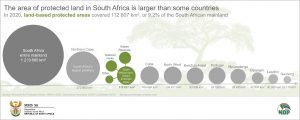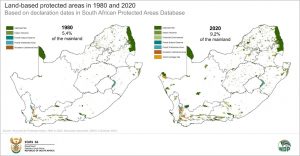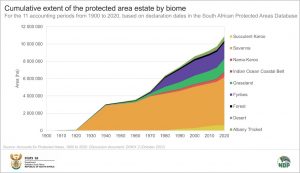The nature of South Africa’s protected area estate
Protected areas are national assets that serve as nodes in South Africa’s ecological infrastructure network, protecting ecosystems that deliver important services to people, such as the production of clean water, flood moderation, prevention of erosion, and the aesthetic value of the landscape.
They provide a home for the country’s most iconic species as well as recreational spaces for South Africans and global visitors. Protected areas can also play an important role in the development of rural economies.
Combing through data from as far back as 1900, the recently released discussion document1 Accounts for Protected Areas, 1900 to 2020 presents an overview of protected land in South Africa, providing valuable insight into the nature of the protected area estate and its growth and development over the past century. The report dives into the South African Protected Area Database (SAPAD), breaking down the data by province, biome, and type of protected area. The analysis does not yet include marine protected areas, which are also an important part of the protected area estate.
Proclaimed by law and managed for biodiversity conservation, land-based protected areas include National Parks, Nature Reserves, Protected Environments, Forest Nature Reserves, Forest Wilderness Areas, Mountain Catchment Areas and World Heritage Sites.
In 2020, the area of protected land was bigger than Cuba
In 2020, protected land accounted for 11 280 684 ha (or 112 807 km2) of the South African mainland. To provide some perspective of scale, 112 807 km2 is about the same size as Cuba. It’s also larger than countries such as Portugal, Denmark and Lesotho. If protected land in South Africa were its own province, it would be larger than North West, KwaZulu-Natal, Mpumalanga or Gauteng.
The protected area estate covers 9,2% of the size of mainland South Africa. In other words, for every 100 square metres of land across the country, just over 9 square metres are protected and managed for biodiversity conservation.
Nature Reserves and National Parks protect our national assets
At the end of 2020, Nature Reserves made up 44,5% of the total protected area estate in 2020, accounting for 4,1% of mainland South Africa. Nature Reserves made up the majority of protected areas in all provinces with the exception of Mpumalanga and Northern Cape. They also make the largest proportional contribution to protecting the Forest, Fynbos, Grassland and Indian Ocean Coastal Belt biomes.
National Parks made up 3,5% of the mainland area of South Africa and contributed 37,4% to the protected area estate at the end of 2020, making the most significant contribution to protected areas in Mpumalanga and Northern Cape. National Parks make the largest proportional contribution to protecting four biomes: Desert, Nama-Karoo, Savanna and Succulent Karoo.
The growing nature of protected areas
The protected area estate has expanded in all provinces and in all biomes across South Africa, but not evenly. The report breaks this down per province and biome over time, which tells all sorts of interesting stories. For instance, the Savanna biome is the largest in South Africa and has been well represented in the protected area estate for a long time, with well-known protected areas such as the Kruger National Park and Pilanesberg Game Reserve. The Desert biome is the second smallest biome in South Africa, and was not protected until the end of the 2000 accounting period. By the end of 2020, 22,4% of the Desert biome was protected.
The growth of the protected area estate can also be expressed as a percentage change in the size of the area for a given period. What is notable about the expansion of protected land in the 2015–2020 period is the rapid increase of Protected Environments, the third biggest type of protected land after National Parks and Nature Reserves.
Many Protected Environments are examples of contract protected areas established through biodiversity stewardship programmes, in which private or communal landowners enter into formal partnerships with conservation authorities. From 2015 to 2020, the land area of Protected Environments increased by 171,4% (or by 5 071 km2). Large areas declared as Protected Environments during this period include Mountain-Zebra Camdeboo, Mphaphuli, Sneeuwberg, Indalo and De Hoop Dam. By the end of 2020, Protected Environments made up 38,0% of the protected area estate in Eastern Cape.
As the globe celebrates World Habitat Day on 4 October, under the theme “Accelerating urban action for a carbon-free world”2, we should pause to contemplate the important role that these protected areas play. With urban centres indirectly responsible for the bulk of greenhouse emissions, protected areas can act as a counterpoise by capturing and storing carbon from the atmosphere. These expanses of land, rich with biodiversity, may become one of our biggest tools against climate change.
For more information, download the Accounts for Protected Areas, 1900 to 2020 discussion document here.
1 This is the second discussion document published as part of the Natural Capital Accounting and Valuation of Ecosystem Services (NCAVES) project in South Africa. This project is jointly led by Stats SA and the South African National Biodiversity Institute (SANBI) in partnership with DFFE and with support globally from UNSD, UNEP and funding from the EU. More information on Natural Capital Accounting in South Africa is available here.
2 UN-Habitat, World Habitat Day, 2021 (read here).
Similar articles are available on the Stats SA website and can be accessed here.
For a monthly overview of economic indicators and infographics, catch the latest edition of the Stats Biz newsletter here.





